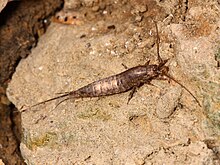
Back عتيقات الفك Arabic عتيقات الفك ARZ Archaeognatha AST Археогнати Bulgarian Arqueògnats Catalan Archaeognatha CEB Chvostnatky Czech Felsenspringer (Insekten) German Αρχαιόγναθα Greek Archaeognatha Spanish
| Archaeognatha Temporal range:
| |
|---|---|

| |
| Rock bristletail | |
| Scientific classification | |
| Domain: | Eukaryota |
| Kingdom: | Animalia |
| Phylum: | Arthropoda |
| Class: | Insecta |
| Subclass: | Monocondylia Haeckel, 1866 |
| Order: | Archaeognatha Börner, 1904 |
| Families[2] | |
| Synonyms | |
| |
The Archaeognatha are an order of apterygotes, known by various common names such as jumping bristletails. Among extant insect taxa they are some of the most evolutionarily primitive; they appeared in the Middle Devonian period at about the same time as the arachnids. Specimens that closely resemble extant species have been found as both body and trace fossils (the latter including body imprints and trackways) in strata from the remainder of the Paleozoic Era and more recent periods.[3] For historical reasons an alternative name for the order is Microcoryphia.[4]
Until the late 20th century the suborders Zygentoma and Archaeognatha comprised the order Thysanura; both orders possess three-pronged tails comprising two lateral cerci and a medial epiproct or appendix dorsalis. Of the three organs, the appendix dorsalis is considerably longer than the two cerci; in this the Archaeognatha differ from the Zygentoma, in which the three organs are subequal in length.[4] In the late 20th century, it was recognized that the order Thysanura was paraphyletic, thus the two suborders were each raised to the status of an independent monophyletic order, with Archaeognatha sister taxon to the Dicondylia, including the Zygentoma.[5]
The order Archaeognatha is cosmopolitan; it includes roughly 500 species in two families.[6] No species is currently evaluated as being at conservation risk.[7]
- ^ Howell V. Daly; John T. Doyen & Alexander H. Purcell (1998). Introduction to Insect Biology and Diversity (2nd ed.). Oxford University Press. ISBN 0-19-510033-6.
- ^ "Order Archaeognatha Börner 1904". The Paleobiology Database. Retrieved 26 November 2020.
- ^ Patrick R. Getty; Robert Sproule; David L. Wagner & Andrew M. Bush (2013). "Variation in wingless insect trace fossils: insights from neoichnology and the Pennsylvanian of Massachusetts". PALAIOS. 28 (4): 243–258. Bibcode:2013Palai..28..243G. doi:10.2110/palo.2012.p12-108r. S2CID 86430759.
- ^ a b Timothy J. Gibb (27 October 2014). Contemporary Insect Diagnostics: The Art and Science of Practical Entomology. Academic Press. pp. 78–. ISBN 978-0-12-404692-4.
- ^ A. Blanke, M. Koch, B. Wipfler, F. Wilde, B. Misof (2014) Head morphology of Tricholepidion gertschi indicates monophyletic Zygentoma. Frontiers in Zoology 11:16 doi:10.1186/1742-9994-11-16
- ^ Barnard, Peter C. (19 September 2011). The Royal Entomological Society Book of British Insects. John Wiley & Sons. ISBN 9781444344967.
- ^ NC State University, ENT 425 | General Entomology | Resource Library | Compendium [Archeognatha]
© MMXXIII Rich X Search. We shall prevail. All rights reserved. Rich X Search